I’m thrilled to sit down with James Maitland, a renowned expert in healthcare policy and antitrust regulation with a deep understanding of how hospital mergers impact communities and markets. With years of experience analyzing the intersection of healthcare access, pricing, and competition, James offers invaluable insights into the recent controversial merger between Union Hospital and Terre Haute Regional Hospital in Indiana. In our conversation, we explore the implications of state-approved mechanisms like Certificates of Public Advantage, the tension between state and federal oversight, the potential effects on patients and workers, and lessons from similar cases across the country.
Can you walk us through what a Certificate of Public Advantage, or COPA, is and why it plays such a critical role in hospital mergers like this one in Indiana?
Absolutely. A Certificate of Public Advantage is essentially a state-level tool that allows hospital mergers to bypass federal antitrust scrutiny under certain conditions. It’s designed to replace market competition with state oversight, meaning that even if a merger creates a monopoly, the state can approve it if they believe the public will benefit. In the case of Union Hospital and Terre Haute Regional Hospital, the COPA was crucial because this merger significantly reduces competition in Vigo County. Without it, federal regulators like the FTC would likely block the deal due to concerns over higher prices and reduced access. The COPA provides a legal shield, but it comes with strings attached—like commitments to price controls or service preservation—that the state must enforce.
How does a COPA differ from the typical federal antitrust rules that usually govern these kinds of mergers?
Federal antitrust rules, under laws like the Sherman Act or Clayton Act, are primarily focused on preserving competition to protect consumers from price gouging, reduced quality, or limited choices. The FTC evaluates mergers based on whether they’ll harm the market. A COPA, on the other hand, flips that script. It allows states to greenlight a merger that might otherwise violate federal rules if they can argue the benefits—like improved access or cost savings—outweigh the downsides. The trade-off is that the state takes on the responsibility of regulating the merged entity to prevent abuse of market power, which is a very different approach from the federal emphasis on maintaining a competitive landscape.
What drove Indiana’s health department to approve this merger despite strong pushback from federal regulators and other critics?
Indiana’s decision hinged on the belief that the merger would deliver specific benefits to the Terre Haute and Vigo County communities. State officials, including Governor Mike Braun, argued that combining Union Hospital and Terre Haute Regional would lower healthcare prices and expand access to services. They also felt confident in the safeguards Union agreed to, like price caps and commitments to maintain care levels. Essentially, the state prioritized these promised local improvements over the broader concerns about reduced competition, betting that their oversight could mitigate any negative effects of creating a monopoly in inpatient services in the area.
What are the major concerns federal regulators like the FTC have raised about this merger’s impact on Indiana residents?
The FTC has been vocal about the risks this merger poses. Their primary worry is that by eliminating competition, the merged entity will have the power to raise healthcare prices without pushback, which hits patients directly in the wallet. They also foresee a potential decline in access to services—hospitals with dominant market share often cut less profitable offerings. On top of that, the FTC highlighted how this could suppress wage growth for hospital workers, since a single employer in the area means less bargaining power for staff. These concerns aren’t just theoretical; they’re based on data from similar mergers showing real harm to communities.
Can you explain the safeguards Union and Terre Haute agreed to under the COPA and how they’re supposed to protect the community?
As part of the COPA, Union and Terre Haute committed to several measures aimed at curbing the downsides of reduced competition. One key piece is price caps, which are intended to prevent drastic cost increases for patients. They also pledged to preserve essential healthcare services in the region, ensuring that critical care doesn’t disappear post-merger. These conditions are meant to act as a safety net, reassuring the state that the merger won’t leave residents worse off. The idea is to balance the loss of competition with enforceable promises that prioritize community health needs over profit motives.
How effective do you think these safeguards will be in the long run, especially given expert skepticism about enforcement?
Honestly, the track record of these safeguards isn’t very encouraging. Experts point out that enforcing these rules after a merger is incredibly challenging. Once a hospital system gains dominant market power, the state’s leverage diminishes—fines or penalties can often just be passed on to patients through higher costs. There’s also the issue of the COPA’s limited duration; some of these stipulations start expiring in five years. Without ongoing competition or strong oversight, there’s a real risk that prices could spike or quality could drop once those guardrails are gone. It’s a gamble, and history suggests the house often wins.
What kind of impact might this merger have on the local healthcare market in Vigo County specifically?
The impact could be profound. The FTC estimates that the combined Union-Terre Haute system will control nearly three-fourths of the inpatient hospital services market in Vigo County. That level of dominance effectively creates a monopoly, meaning patients and insurers have little to no alternative options. Without competition, there’s less incentive to keep prices down or innovate in care delivery. It could also affect nearby smaller providers or clinics, squeezing them out or limiting their ability to compete. For the community, this might mean fewer choices and potentially higher costs over time.
Looking at past COPA-approved mergers in other states, what lessons can Indiana learn from those experiences?
Past examples paint a cautionary picture. Take Ballad Health in Tennessee and Virginia—after their COPA was approved in 2018, emergency room wait times tripled, and quality metrics often fell short, yet the state struggled to hold them accountable due to weak enforcement mechanisms. Similarly, Mission Health in North Carolina saw inpatient prices jump 20% during their COPA and even more after it was repealed. These cases show that promised benefits don’t always materialize, and without robust oversight, costs and care quality can suffer. Indiana needs to be proactive in monitoring and enforcing commitments, or they risk repeating these mistakes.
What is your forecast for the future of hospital mergers and COPAs in the U.S., given the growing tension between state and federal priorities?
I think we’re at a crossroads. On one hand, states are increasingly turning to COPAs as a way to address local healthcare challenges, especially in rural areas where hospitals are struggling financially. They see mergers as a lifeline. On the other hand, federal regulators are ramping up their warnings about the long-term harms of reduced competition, backed by solid evidence of price hikes and quality declines. I expect this friction to grow, potentially leading to legal battles or new federal policies to limit COPAs. For now, the trend of states approving these deals will likely continue, but if outcomes like Indiana’s don’t deliver on promises, we could see a major push for reform or stricter federal oversight in the next decade.









